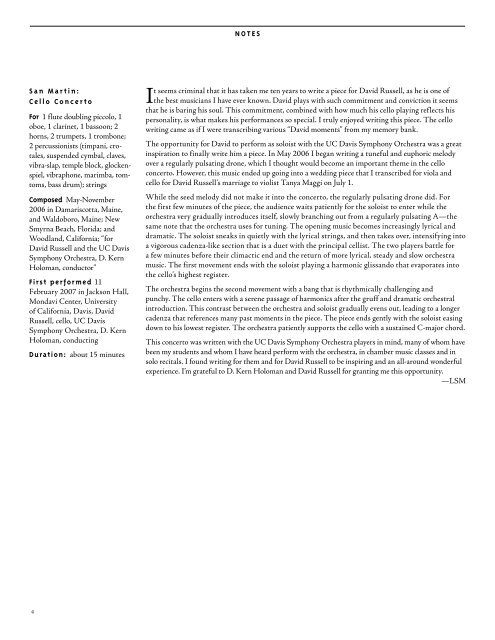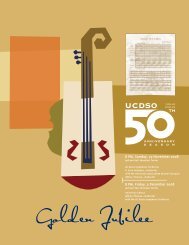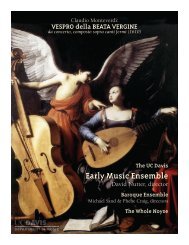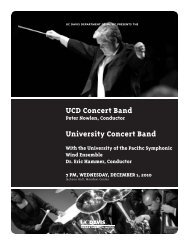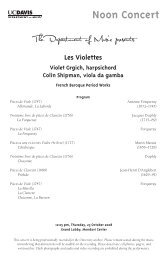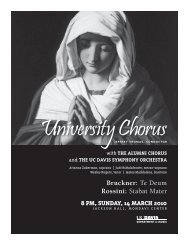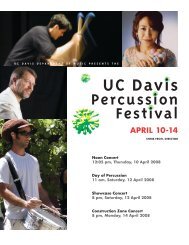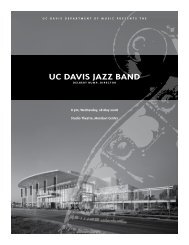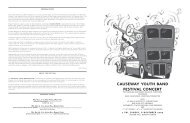to get the file - UC Davis: Department of Music - University of ...
to get the file - UC Davis: Department of Music - University of ...
to get the file - UC Davis: Department of Music - University of ...
Create successful ePaper yourself
Turn your PDF publications into a flip-book with our unique Google optimized e-Paper software.
s a n m a r t i n :<br />
c e l l o c o n c e r t o<br />
for flute doubling piccolo,<br />
oboe, clarinet, bassoon;<br />
horns, trumpets, trombone;<br />
percussionists (timpani, crotales,<br />
suspended cymbal, claves,<br />
vibra-slap, temple block, glockenspiel,<br />
vibraphone, marimba, <strong>to</strong>m<strong>to</strong>ms,<br />
bass drum); strings<br />
composed May-November<br />
006 in Damariscotta, Maine,<br />
and Waldoboro, Maine; New<br />
Smyrna Beach, Florida; and<br />
Woodland, California; “for<br />
David Russell and <strong>the</strong> <strong>UC</strong> <strong>Davis</strong><br />
Symphony Orchestra, D. Kern<br />
Holoman, conduc<strong>to</strong>r”<br />
first per formed<br />
February 007 in Jackson Hall,<br />
Mondavi Center, <strong>University</strong><br />
<strong>of</strong> California, <strong>Davis</strong>, David<br />
Russell, cello, <strong>UC</strong> <strong>Davis</strong><br />
Symphony Orchestra, D. Kern<br />
Holoman, conducting<br />
Duration: about 5 minutes<br />
4<br />
n o t e s<br />
It seems criminal that it has taken me ten years <strong>to</strong> write a piece for David Russell, as he is one <strong>of</strong><br />
<strong>the</strong> best musicians I have ever known. David plays with such commitment and conviction it seems<br />
that he is baring his soul. This commitment, combined with how much his cello playing reflects his<br />
personality, is what makes his performances so special. I truly enjoyed writing this piece. The cello<br />
writing came as if I were transcribing various “David moments” from my memory bank.<br />
The opportunity for David <strong>to</strong> perform as soloist with <strong>the</strong> <strong>UC</strong> <strong>Davis</strong> Symphony Orchestra was a great<br />
inspiration <strong>to</strong> finally write him a piece. In May 006 I began writing a tuneful and euphoric melody<br />
over a regularly pulsating drone, which I thought would become an important <strong>the</strong>me in <strong>the</strong> cello<br />
concer<strong>to</strong>. However, this music ended up going in<strong>to</strong> a wedding piece that I transcribed for viola and<br />
cello for David Russell’s marriage <strong>to</strong> violist Tanya Maggi on July .<br />
While <strong>the</strong> seed melody did not make it in<strong>to</strong> <strong>the</strong> concer<strong>to</strong>, <strong>the</strong> regularly pulsating drone did. For<br />
<strong>the</strong> first few minutes <strong>of</strong> <strong>the</strong> piece, <strong>the</strong> audience waits patiently for <strong>the</strong> soloist <strong>to</strong> enter while <strong>the</strong><br />
orchestra very gradually introduces itself, slowly branching out from a regularly pulsating A—<strong>the</strong><br />
same note that <strong>the</strong> orchestra uses for tuning. The opening music becomes increasingly lyrical and<br />
dramatic. The soloist sneaks in quietly with <strong>the</strong> lyrical strings, and <strong>the</strong>n takes over, intensifying in<strong>to</strong><br />
a vigorous cadenza-like section that is a duet with <strong>the</strong> principal cellist. The two players battle for<br />
a few minutes before <strong>the</strong>ir climactic end and <strong>the</strong> return <strong>of</strong> more lyrical, steady and slow orchestra<br />
music. The first movement ends with <strong>the</strong> soloist playing a harmonic glissando that evaporates in<strong>to</strong><br />
<strong>the</strong> cello’s highest register.<br />
The orchestra begins <strong>the</strong> second movement with a bang that is rhythmically challenging and<br />
punchy. The cello enters with a serene passage <strong>of</strong> harmonics after <strong>the</strong> gruff and dramatic orchestral<br />
introduction. This contrast between <strong>the</strong> orchestra and soloist gradually evens out, leading <strong>to</strong> a longer<br />
cadenza that references many past moments in <strong>the</strong> piece. The piece ends gently with <strong>the</strong> soloist easing<br />
down <strong>to</strong> his lowest register. The orchestra patiently supports <strong>the</strong> cello with a sustained C-major chord.<br />
This concer<strong>to</strong> was written with <strong>the</strong> <strong>UC</strong> <strong>Davis</strong> Symphony Orchestra players in mind, many <strong>of</strong> whom have<br />
been my students and whom I have heard perform with <strong>the</strong> orchestra, in chamber music classes and in<br />
solo recitals. I found writing for <strong>the</strong>m and for David Russell <strong>to</strong> be inspiring and an all-around wonderful<br />
experience. I’m grateful <strong>to</strong> D. Kern Holoman and David Russell for granting me this opportunity.<br />
—LSM


